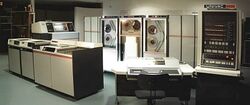Engineering:UNIVAC 9000 series

The UNIVAC 9000 series (9200, 9300, 9400, 9700) is a discontinued line of computers introduced by Sperry Rand in the mid-1960s to compete with the low end of the IBM System/360 series. The 9200 and 9300 (which differ only in CPU speed) implement the same restricted 16-bit subset of the System/360 instruction set as the IBM 360/20,[1] while the UNIVAC 9400 implements a subset of the full 32-bit System/360 instruction set.[2] The 9400 was roughly equivalent to the IBM 360/30.
In 1972, UNIVAC stopped development of its 9000 series systems, in favor of hardware acquired from RCA, now called UNIVAC Series 90.
Hardware
The 9000 series uses monolithic integrated circuits for logic[3][4] and plated-wire memory;[3] the latter functions somewhat like core memory but uses a non-destructive read. Since the 9000 series was intended as direct competitors to IBM, they use 80-column cards and EBCDIC character encoding.
The UNIVAC 9200 was marketed as a functional replacement for the 1004 and as a direct competitor to the IBM 360/20. The printer-processor is one cabinet, the power supply and memory another and the card reader and optional card punch make an L-shaped configuration. Memory is 8 KB expandable to 32 KB.[1] The 9200 II and 9300 II models, introduced in 1969, are extensions of the original 9200 and 9300 systems.[3]
The printer differs from earlier UNIVAC printers, being similar to IBM's "bar printer" of the same era. It uses an oscillating-type bar instead of the drums that had been used until this point, and runs at speeds up to 300 lines per minute.
As Sperry moved into the 1970s, they expanded the 9000 family with the introduction of the 9700 system in 1971.[5] The 9700 was said to be three to five as powerful as the 9400, twice as powerful as the IBM System/360 Model 50, and less costly than the IBM System/370 Model 145.[6]
Software
The 9200 and 9300 run the Minimum Operating System.[7] The 9400 and 9480 run a real memory operating system called OS/4.[8] A new operating system for the 9700, called OS/7 was under development, but was discontinued in 1975.[9][10]
References
- ↑ 1.0 1.1 "UNIVAC 9200/9300 Series Processor and Storage Programmer Reference". Sperry-Rand Corporation. 1973. http://bitsavers.org/pdf/univac/9x00/UP-7546R1_9000progRef1973.pdf.
- ↑ "9400 System". Sperry-Rand Corporation. 1967. http://bitsavers.org/pdf/univac/9x00/UP-7566_9400_SystemDescr_1967.pdf.
- ↑ 3.0 3.1 3.2 "Univac 9000 Series Facts and Figures". Sperry-Rand Corporation. May 1969. http://www.bitsavers.org/pdf/univac/9x00/U5016_Univac_9000_Series_Facts_and_Figures_May69.pdf.
- ↑ Colbert, Douglas A. (1974) (in en). Computers and management for business. Petrocelli Books. p. 27. ISBN 9780884050643. https://books.google.com/books?id=BUIPAQAAMAAJ&q=%22univac+9700%22+monolithic.
- ↑ Gray, George T.; Smith, Ronald Q. (2001). "Sperry Rand's Third-Generation Computers 1964-1980". IEEE Annals of the History of Computing (IEEE Computer Society) 23 (1): 3–16. doi:10.1109/85.910845.
- ↑ Piasta, Frank (Nov 17, 1971). "Univac 9700 Offers Compatibility, Price". Computerworld. https://books.google.com/books?id=wCl2yLDv2bAC&pg=PT1.
- ↑ UNIVAC 9200/9200 / 9300/9300 II Systems Minimum Operating System. UNIVAC Corporation. 1972. p. 2.12. http://bitsavers.org/pdf/univac/9x00/UP-7547r2_Minimum_Operating_System_Programmers_Reference.pdf. Retrieved Oct 17, 2019.
- ↑ "Records of Sperry-UNIVAC Acc. 1825 Record Group 2". Acc. 1825 Record Group 2 - The Records of Sperry-UNIVAC Series VI: Technical Records - Software Publications Files, Continued. http://findingaids.hagley.org/xtf/docs/1825_II.pdf.
- ↑ "UNIVAC 90/60,90/70, and 90/80". Datapro. September 1976. http://bitsavers.informatik.uni-stuttgart.de/pdf/univac/series_90/datapro/70C-877-06_7609_UNIVAC_90-60_70_80.pdf.
- ↑ "Univac 9000, Series 70 Sites Promised Help Moving to VS/9". Computerworld. November 26, 1975. https://books.google.com/books?id=nMHHJQxdDHYC&pg=PA11.
External links
- Operational Univac 9400 in the German computer history museum technikum29
 |

